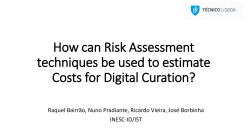
2_Research data management plan
Social science research is increasingly complex and ambitious. Along with the challenge of developing and analysing data is the imperative to manage that data to meet expectations of transparency, replication and reuse. An increasing number of funding agencies require a research data management plan to be part of the funding application process, and even if not required, research data management planning is often encouraged. Accordingly, at the conception of research projects researchers should undertake a process of identifying and planning research data management activities. Once mapped, you can then approach these activities with a strategy in place before the starting data collection. What is a research data management plan? A data management plan describes strategies for the collection, storage, validation, security, preservation, and sharing of data where possible, throughout the data lifecycle. Often researchers must address these issues anyway, either in funding proposals or as part of research. Therefore, it is worthwhile to think early about how you will deal with them overall rather than react and improvise later on. The data lifecycle and research data management CESSDA AS CESSDA House Parkveien 20 5007 Bergen NORWAY phone: +47 55 58 21 18 e-mail: cessda@cessda.net www.cessda.net Consortium of European Social Science Data Archives Research data management plan The contents of the data management plan A data management plan should generally include: Project description: It identifies the type(s) of data created or used and describes the file formats you will use as well as why these are appropriate. Consent: It states procedures to obtain informed consent and strategies to protect research participants. Data ownership: It assigns intellectual property rights for use and conditions of re-use. Data re-use and accessibility: It clarifies plans for making the data available to others, including outlining potential restrictions for re-use and strategies to address them, and summarizes the metadata as well as contextual documentation, making the data comprehendible. Research data management support: It outlines the envisioned roles and responsibilities for implementing research data management within the research team and institution(s) as well as explores IT support for data and documentation back-up and security, and addresses strategies for sharing data across institutions. Like research itself, research data management is a dynamic process. Researchers must expand a plan into policies and procedures and then review and adjust as circumstances change. This could be a reaction to technological developments, turnover in personnel, institutional or other policy changes. References and further reading DCC (2013): Checklist for a Data Management Plan. v.4.0. Edinburgh: Digital Curation Centre. http://www.dcc.ac.uk/resources/data-management-plans. ICPSR (2011): Guidelines for Effective Data Management Plans. http://www.icpsr.umich.edu/files/datamanagement/DataManagementPlans-All.pdf. Jones, S. (2011): How to Develop a Data Management and Sharing Plan. Glasgow: Digital Curation Centre (DCC). http://www.dcc.ac.uk/resources/how-guides/develop-data-plan. This work is licensed under a Creative Commons Attribution 4.0 International License. 2
© Copyright 2025


















